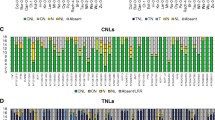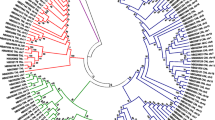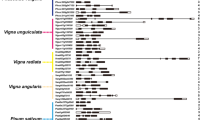Abstract
The activated disease resistance (ADR) 1 gene encodes a protein that possesses an N-terminal coiled-coil (CC) motif, nucleotide-binding site (NBS) and C-terminal leucine-rich repeat (LRR) domains. ADR1 belongs to a small, atypical Arabidopsis thaliana sub-class containing four CC–NBS–LRR genes. The NBS region of most NBS–LRR proteins possesses numerous conserved motifs. In contrast, the LRR domain, which is subject to positive selection, is highly variable. Surprisingly, sequence analysis revealed that the LRR domain of the ADR1 sub-class was more conserved than the NBS region. Sequence analysis identified two novel conserved motifs, termed TVS and PKAE, specific for this CC–NBS–LRR sub-class. The TVS motif is adjacent to the P-loop, whereas the PKAE motif corresponded to the inter-domain region termed the NBS–LRR linker, which was conserved within the different CC–NBS–LRR classes but varied among classes. These ADR1-specific motifs were employed to identify putative ADR1 homologs in phylogenetically distant and agronomically important plant species. Putative ADR1 homologs were identified in 11 species including rice and in 3 further Poaceae species. The ADR1 sub-class of CC–NBS–LRR proteins is therefore conserved in both monocotyledonous and dicotyledonous plant species.



Similar content being viewed by others
References
Ashfield T, Ong LE, Nobuta K, Schneider CM, Innes RW (2004) Convergent evolution of disease resistance gene specificity in two flowering plant families. Plant Cell 16:309–318
Bailey T L, Elkan C (1995) The value of prior knowledge in discovering motifs with MEME. Proc Int Conf Intell Syst Mol Biol 3:21–29
Baumgarten A, Cannon S, Spangler R, May G (2003) Genome-level evolution of resistance genes in Arabidopsis thaliana. Genetics 165:309–319
Bork P, Brown NP, Hegyi H, Schultz J (1996) The protein phosphatase 2C (PP2C) superfamily: detection of bacterial homologues. Protein Sci 5:1421–1425
Cannon SB, Zhu H, Baumgarten AM, Spangler R, May G, Cook DR, Young ND (2002) Diversity, distribution, and ancient taxonomic relationships within the TIR and non-TIR NBS–LRR resistance gene subfamilies. J Mol Evol 54:548–562
Chenna R, Sugawara H, Koike T, Lopez R, Gibson TJ, Higgins DG, Thompson JD (2003) Multiple sequence alignment with the Clustal series of programs. Nucleic Acids Res 31:3497–3500
Chini A, Grant JJ, Seki M, Shinozaki K, Loake GJ (2004) Drought tolerance established by enhanced expression of the CC-NBS-LRR gene, ADR1, requires salicylic acid, EDS1 and ABI1. Plant J 38:810–822
Dangl JL, Jones JD (2001) Plant pathogens and integrated defence responses to infection. Nature 411:826–833
Ellis RP, Forster BP, Robinson D, Handley LL, Gordon DC, Russell JR, Powell W (2000) Wild barley: a source of genes for crop improvement in the 21st century? J Exp Bot 51:9–17
Felsenstein J (1989) PHYLIP—phylogeny inference package, version 3.2. Cladistics 5:164–166
Grant JJ, Chini A, Basu D, Loake GJ (2003) Targeted activation tagging of the Arabidopsis NBS-LRR gene, ADR1, conveys resistance to virulent pathogens. Mol Plant Microbe Interact 16:669–680
Jia Y, McAdams SA, Bryan GT, Hershey HP, Valent B (2000) Direct interaction of resistance gene and avirulence gene products confers rice blast resistance. Embo J 19:4004–4014
Kobe B, Kajava AV (2001) The leucine-rich repeat as a protein recognition motif. Curr Opin Struct Biol 11:725–732
Meyers BC, Chin DB, Shen KA, Sivaramakrishnan S, Lavelle DO, Zhang Z, Michelmore RW (1998) The major resistance gene cluster in lettuce is highly duplicated and spans several megabases. Plant Cell 10:1817–1832
Meyers BC, Dickerman AW, Michelmore RW, Sivaramakrishnan S, Sobral BW, Young ND (1999) Plant disease resistance genes encode members of an ancient and diverse protein family within the nucleotide-binding superfamily. Plant J 20:317–332
Meyers BC, Kozik A, Griego A, Kuang H, Michelmore RW (2003) Genome-wide analysis of NBS-LRR-encoding genes in Arabidopsis. Plant Cell 15:809–834
Michelmore RW, Meyers BC (1998) Clusters of resistance genes in plants evolve by divergent selection and a birth-and-death process. Genome Res 8:1113–1130
Mondragon-Palomino M, Meyers BC, Michelmore RW, Gaut BS (2002) Patterns of positive selection in the complete NBS-LRR gene family of Arabidopsis thaliana. Genome Res 12:1305–1315
Noel L, Moores TL, van Der Biezen EA, Parniske M, Daniels MJ, Parker JE, Jones JD (1999) Pronounced intraspecific haplotype divergence at the RPP5 complex disease resistance locus of Arabidopsis. Plant Cell 11:2099–2112
Pan Q, Wendel J, Fluhr R (2000) Divergent evolution of plant NBS-LRR resistance gene homologues in dicot and cereal genomes. J Mol Evol 50:203–213
Parniske M, Hammond-Kosack KE, Golstein C, Thomas CM, Jones DA, Harrison K, Wulff BB, Jones JD (1997) Novel disease resistance specificities result from sequence exchange between tandemly repeated genes at the Cf-4/9 locus of tomato. Cell 91:821–832
Staskawicz BJ, Ausubel FM, Baker BJ, Ellis JG, Jones JDG (1995) Molecular genetics of plant disease resitance. Science 248:189–194
Thomas D, Rozell TG, Liu X, Segaloff DL (1996) Mutational analyses of the extracellular domain of the full-length lutropin/choriogonadotropin receptor suggest leucine-rich repeats 1-6 are involved in hormone binding. Mol Endocrinol 10:760–768
Wang GL, Ruan DL, Song WY, Sideris S, Chen L, Pi LY, Zhang S, Zhang Z, Fauquet C, Gaut BS et al. (1998) Xa21D encodes a receptor-like molecule with a leucine-rich repeat domain that determines race-specific recognition and is subject to adaptive evolution. Plant Cell 10:765–779
Zhu H, Cannon SB, Young ND, Cook DR (2002) Phylogeny and genomic organization of the TIR and non-tIR NBS-LRR resistance gene family in Medicago truncatula. Mol Plant Microbe Interact 15:529–39
Acknowledgements
We would like to thank Dietlind Gerloff for critically reading this manuscript. AC was the recipient of a Darwin Trust Studentship. This work was supported by BBSRC grant P16595 to GJL.
Author information
Authors and Affiliations
Corresponding author
Rights and permissions
About this article
Cite this article
Chini, A., Loake, G.J. Motifs specific for the ADR1 NBS–LRR protein family in Arabidopsis are conserved among NBS–LRR sequences from both dicotyledonous and monocotyledonous plants. Planta 221, 597–601 (2005). https://doi.org/10.1007/s00425-005-1499-3
Received:
Accepted:
Published:
Issue Date:
DOI: https://doi.org/10.1007/s00425-005-1499-3




